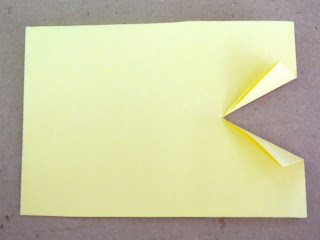The students loved using play-dough to make their favorite food items. It was a very fast activity, in which I handed out a small piece of colored dough for them to mold their food and write it on a piece of paper. Next class, peers will interview each student about it.
Wednesday, August 24, 2011
Food Categories - Where do fruit and vegetables grow? - Pop-Up Book
Using the pop-up book is an involving way for the students to classify different food items: Do they grow on trees, on plants, or underground? We used one page for each category.
Here are the steps for a dimensional effect on the project:
1. For each page, fold an A5 sheet of paper in half and cut slits down from the fold. Narrow slits for the tree and wide slits for the plant / underground.
2. Push the cut area through the fold and crease it to form a pop-up section.
3. Glue the 3 pages back to back.
4. Label the pictures.
Friday, August 19, 2011
Food - Step Book
This is the project my group is going to develop to write about the food they like and don't like for different meals. They'll choose among breakfast, lunch, or dinner.
1. For each student, 2 A4 sheets cut in half. They receive 4 A5 sheets.
2. Place the four sheets of paper on top of one another, overlapping the ends.
3. Hold the pages together and fold them over to create more overlapping pages. Staple it.
4. Write the book title on the top page (students choose one mealtime: breakfast, lunch, or dinner), write the sentences - I like ... / I don't like ... , and draw the respective food item on each succeeding page.
Here's the sample the students will be exposed to:
Monday, August 8, 2011
Stand-up Animals
This is the project my group developed after we talked about pets and zoo animals. It focused on the animals they can usually see at the zoo.
First I set five minutes for them to color the pictures. Then five more minutes for them to cut out the animals and glue them to the cages they wanted. Finally, they wrote the animal words on the respective signs, read the words for me individually, and taped their projects to the wall.
Here are their projects.
Animal Pop-Up Cards
My group made this pop-up card to illustrate the pets they have or would like to have. It gave a dimensional effect to the project.
Here are the directions:
1. Fold two pieces of paper in half. Put one aside.Starting at the folded edge, cut a line. The longer the line, the bigger the mouth.

2. Fold back the flaps to form two triangles.
3. Open the flaps again. Open the whole page.
Put your finger on the top triangle and push down. Pinch the two folded edges of the top triangle, so that the triangle is pushed through to the other side of the paper.
Put your finger on the bottom triangle and do the same thing. The top and bottom triangles will now be pushed out to form a mouth inside the card. When you open and close your card, the mouth will look like it is talking. When your card is closed it will look like this:
4. Glue the inside and outside cards together. Do not apply glue in the area of the pop-up mouth. You now have a cover for your card.
5. Draw an animal around your mouth.
Here's an example of a frog.
Here's an example of a frog.
And here's an example of a dog. Following the content covered in the lesson, the students wrote, e.g. I have a dog. I don't have a cat.
Here are some samples you can show to your students to model the project.
Here are the students' projects:
Paper Plate Animals
Paper plates - here are some ideas you can use to work with pets and wild animals. I handed out the animal plates and the respective word slips for the students to match. They also classified the animals as pets and wild animals, or both, and talked about their colors.

Subscribe to:
Comments (Atom)




































